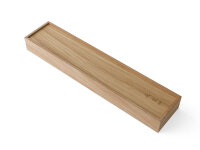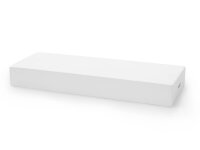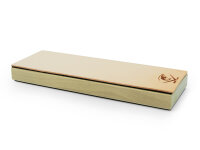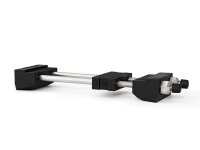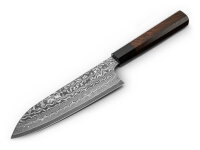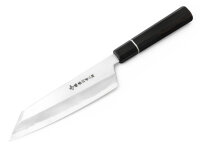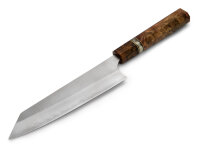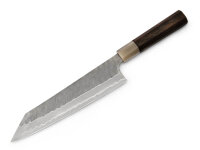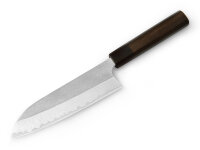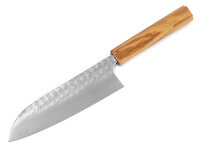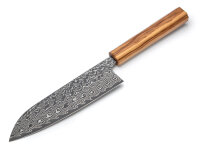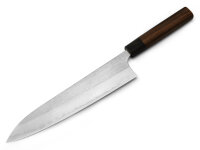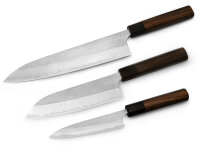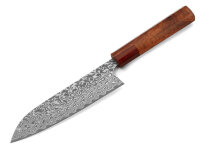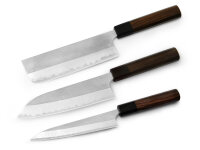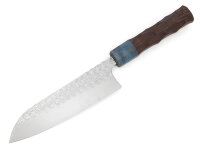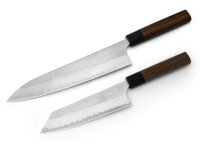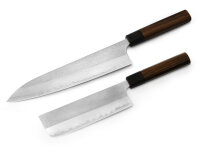"Special Edition Santoku Knife 165, Yoshimi Kato Nashiji"
Hiroshi Kato – A True Master of Japanese Knives
He is the second blacksmith and knife maker of his family. He inherited the intricate art of forging exceptionally high-quality knives from his father, Kintaro Kato. Traditionally, this was the established route for passing down the skills and "secrets" of the masters. While tradition holds significant importance to Hiroshi Kato, he also embraces change. He co-founded the Takefu Knife Village along with other blacksmith masters with the goal of preserving ancient knowledge, sharing experiences, and mentoring young blacksmiths. One such young blacksmith was Yoshimi Kato, Hiroshi's son and successor, who now also stands among the masters. After nearly 60 years of diligent work, Hiroshi Kato now mostly sets aside the blacksmith hammer, focusing mainly on quality assurance, innovation, and education. In 2008, Hiroshi Kato was awarded the certificate of traditional craftsman, a prestigious recognition of artisanal excellence.
Special Edition Yoshimi Kato Nashiji, Handle by Joe Morrone
These knives are truly unique pieces: 6 Santoku, 6 Bunka. No more exist, and there won't be any more in the future. The blade follows the Nashiji series design by Yoshimi Kato. The handles are crafted by Joe Morrone. Joe is enamored with Japanese knives. His personal craftsmanship, bordering on the artistic, focuses on the handles. His handle designs are unparalleled. The foundation is always the material, particularly the rare and invariably beautiful woods he discovers and meticulously processes for the handles. For our special edition, we chose a Rosewood root from Honduras. More specifically, they are called Burls – growths on the trunks which are harvested. Burls are renowned for their unique and strong grain, making them a favorite in artistic woodworking and subsequently high in value. This wood is extremely rare, and Joe believes he used the last of his stock for our handles. Thus, our special edition has a limited run of only 12 pieces. In addition to the precious Rosewood, the handle also features an expensive and high-quality adornment made from musk ox horn. This beautiful, bright decorative element is situated at the front of the handle, surrounded by stripes of nickel silver. The handle concludes with a contrasting piece of Desert Ironwood, renowned for its hardness. As for the knife blade, the Nashiji is made of blue paper steel, one of the most popular knife steels in Japan. This steel is more wear-resistant than Shirogami, thus offering enhanced edge retention, remarkable hardness, and an impressive sharpening potential. Master Yoshimi Kato, Hiroshi Kato's son, has meticulously "fire polished" the Nashiji series. The encapsulating steel and Nashiji finish not only look exquisite but also provide rust protection, although it's not stainless by European standards. With proper care, rusting is almost preventable. However, the steel's nature can lead to some discoloration of the edge due to moisture or acidity. With proper care, the joy of using this knife can last a lifetime. The finish, Nashiji or "Pear Skin Finish", is a Japanese specialty. Functionally, it provides additional protection to the delicate blade and facilitates easier cutting by reducing the adhesion of sliced food. Ultra-thin fillets of fish or meat and finely sliced vegetables don't stick as much to the blade. Visually, Pear Skin is a real treat for aficionados; Japanese knives with this finish are highly sought-after. The dotted structure and fine satin sheen grant the knife its unique charm and character.
Usage Instructions
Japanese chef knives are crafted from exceptionally hard steels, making them thinner in design and sharpening than their European counterparts. Some of these knives have very finely honed edges, making them more delicate and suitable exclusively for soft ingredients. Refer to the product details for related information. In particular, knives with a very thin edge and hollow grind are prone to chipping. These are ideal for finely slicing soft ingredients, but they must be used with care. When sharpening on a whetstone, an angled grind is typically formed, making the edge sturdier over time.
Chipping can also occur due to leverage or when cutting frozen food, which can significantly reduce the steel's temperature. Leverage is often applied when cutting ingredients with bones. Chips on the blade may need to be professionally sharpened out.
Always use the knife with straight pulling or pushing cuts, without applying excessive pressure. To maintain sharpness, avoid cutting on hard surfaces such as stone or glass. Never use a "sharpening steel" for re-sharpening. Instead, water sharpening stones are recommended (grit: 400-1200 for initial sharpening, 3000 for fine sharpening, and 6000 or more for honing the blade). A honing leather may also be required.
Keep the knife out of children's reach. These knives are incredibly sharp, so exercise caution.
Each product is unique, so slight deviations from the depicted image are possible.
Care Instructions
When using knives made of sensitive steel types, like Aogami, Shirogami, or V-Toku, clean them occasionally with a cloth and water, drying them thoroughly. This step will prevent rust from forming. They should not be left in a moist environment for long periods, especially in places where they may come into contact with salty or acidic ingredients. Regular maintenance with a knife oil or camellia oil can also enhance protection against rust. Apply a thin layer of oil on the blade after cleaning and drying thoroughly. Store the knife in a dry place, preferably in a wooden or plastic sheath. Never store the knife in a leather sheath, as the leather retains moisture and can cause rusting. For knives with wooden handles, periodically treat the handle with a suitable wood care oil. This process will prevent the wood from becoming brittle and ensure a secure grip.
Never wash Japanese chef knives in a dishwasher. The aggressive detergents, high temperatures, and strong water jets can damage the delicate edge and blade, as well as the handle. Instead, always clean them by hand with a sponge or cloth, lukewarm water, and a bit of dish soap. After cleaning, immediately dry the knife with a towel.
Regularly check the knife's blade for damage or rust, especially when using it less frequently. In the event of rust formation, you can use a soft cloth and rust eraser or a specialized knife cleaning product. Rust can also be prevented by always cleaning the blade immediately after use, thoroughly drying it, and then storing it properly.

